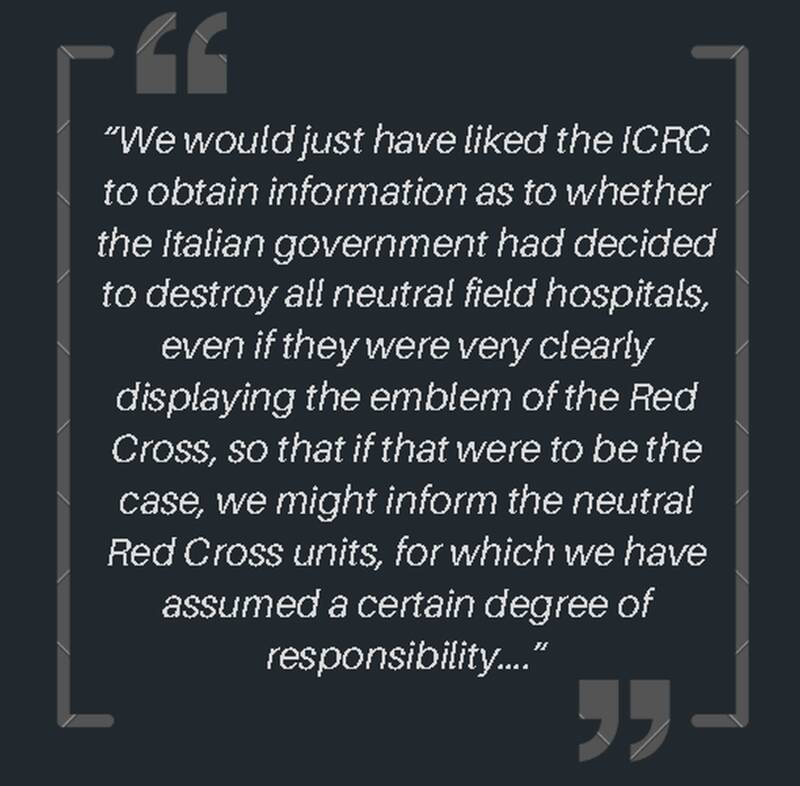The British Red Cross
The Italian victory appeared imminent in March 1936. The last remnants of the Ethiopian forces that were still engaged in battle were being slowly eliminated by the Italian army.
These included the forces in Tigray led by Ras Moulougueta and Ras Kassa, for whom the British Red Cross field hospital was charged with providing medical care.
In terms of safety, the staff of the British ambulance had faith in the two large red cross flags (measured 10 m m x 10 m and 14 m x 14 m) that it placed out on the ground as soon as it arrived at the Korem Plain on 2nd March 1936, despite the attacks that some of its "sister ambulances" had endured.

Devastation after the Italian attack.
They had no idea that the Italian Air Force, which had been keeping watch over them since 29th February, believed they were harbouring Ethiopian soldiers and weapons. On 4th March 1936, One Italian Air Force pilot, Guido Vedovato, arrived over the Red Cross hospital and - fully believing these claims - commenced attacking. He had decided that one of the Red Cross trucks was transporting weapons and that there was suspicious behaviour occurring. He fired at the hospital and dropped a 24 kg of bombs on it.
Later that day, another 774 kg of explosives were dropped, bringing death and disaster to the hospital. Five victims were killed, and others suffered injuries.
Korem Plain following the destruction of the British field hospital by the Italian Air Force.
There were no injuries among the hospital employees although there was significant destruction to the facilities. Along with some medical equipment, two trucks, and the biggest of the two flags—measuring 14 m by 14 m—on which the hospital had depended for visibility and protection—35 tents were also destroyed. With the hospital severely damaged, the staff quickly dispersed, leaving behind the damaged supplies and equipment and the hastily buried bodies of four of the victims in bomb craters.
Violations of the Geneva Convention
Dr Marcel Junod of the Red Cross gave the Italians the benefit of the doubt regarding whether the bombing of the hospital had been intentional or unintentional, but Sydney Brown, a lawyer, was more dubious – seeing the incident as a further intentional violation of the Geneva Convention by the belligerent Italians, and one which called for a stronger response from the ICRC (International Committee of the Red Cross) as well as more time and attention being given to the escalating situation in order to secure real guarantees from Mussolini's government that further incident would not occur (whether such guarantees from Mussolini – should be they be forthcoming – could be relied upon is another matter).
On 12 March 1936, in his report to his colleagues in Geneva, Brown wrote:
The aftermath of the Italian attack on the British Red Cross unit.
ICRC president Max Huber and his committee colleagues agreed to send a delegation to Rome to raise the issue with the Italian government after realising that Mussolini's "pious expectations" had not stopped the bombing of Red Cross and Red Crescent field hospitals. On 24th March 1936, three weeks after the attack on the British field hospital, the delegation landed in Rome.

They calmly listened to Filippo Cremonesi's and the fascist authorities' explanations, who continued to advance the thesis that the episodes were unintended consequences of the challenge of distinguishing the Red Cross and Red Crescent insignia from the air. However, the Italian Air Force had recognised the emblem some days prior to the attack in the case of the British field hospital (and others).
The ICRC delegation left Rome having satisfied itself with its meeting and without having looked into the discrepancies between the testimonies of the victims, its own delegates, and the Ethiopians on the one hand, and the responses given by the fascist government on the other. They also reminded the Italian authorities that they were never to carry out retaliation against the Red Cross or the Red Crescent, under any circumstances.
Picking through the remains: The British Red Cross ambulance unit after the attack by the Italian air force.
However, these measures were taken too late, and the Red Cross and Red Crescent units had to take other measures to safeguard themselves, including avoiding official or diplomatic channels.






